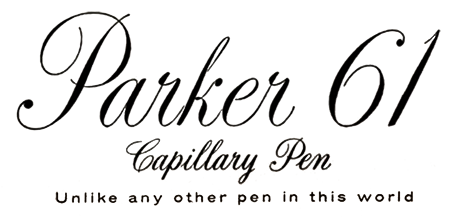Parker 61 Jet Flighter 1959-1962
by Jim Mamoulides, January 29, 2010, updated October 25, 2024
 Parker 61 Jet Flighter 1959-1962
Parker 61 Jet Flighter 1959-1962
The Threat of the Ballpoint Pen
The 1950s saw the rise of the inexpensive and simple to use ballpoint pen, threatening the profitable core business of fountain pen manufacturers and inspiring them to numerous responses including developing their own new ballpoint pens and new cleaner and simpler filling fountain pen designs. The Sheaffer Snorkel, introduced in 1952, provided customers a fountain pen that could fill from a bottle without wiping. Waterman and Sheaffer introduced cartridge filling fountain pens that could be refilled as easily and as cleanly as a ballpoint pen. Parker developed not only new ballpoint pens but also worked on simplifying the fountain pen filling process.
In 1956 Parker introduced probably the simplest successful fountain pen filling system with the Parker 61. This new pen needed no moving parts to fill with ink, using capillary action to draw ink into the pen. Inside the "capillary cell" permanently attached to the nib section is a rolled, thin, perforated polyethylene sheet and the filling unit’s base has three holes that allow inflow of ink from the bottle. It draws in ink by inserting the base of the filling unit into the inkwell and letting the perforated polyethylene sheet wick it into the cell in the same manner that water is drawn up a cotton thread by dipping one end. Surface tension holds the ink inside the filling unit until it is drawn through the feed to the nib. The outside of the filling unit is Teflon coated, so ink will not stick to it when it is removed from the ink bottle, making the filling activity simple and clean.
Parker ran celebrity advertisements illustrating how easy it was to fill by showing the pen's nib unit sitting point up in an ink bottle with the person watching and waiting for it to finish. The campaign ran five months in 1957 in Life magazine, the Saturday Evening Post, and later in Esquire. From August through December, they featured Carl Sandburg, William Holden, Doris Day, Charles Coburn, and Bob Hope, each patiently peering at their cool new pen as it filled. Parker's advertisements described it this way: "New kind of pen even fills itself by itself – this new way."
The Pen for the Jet Age
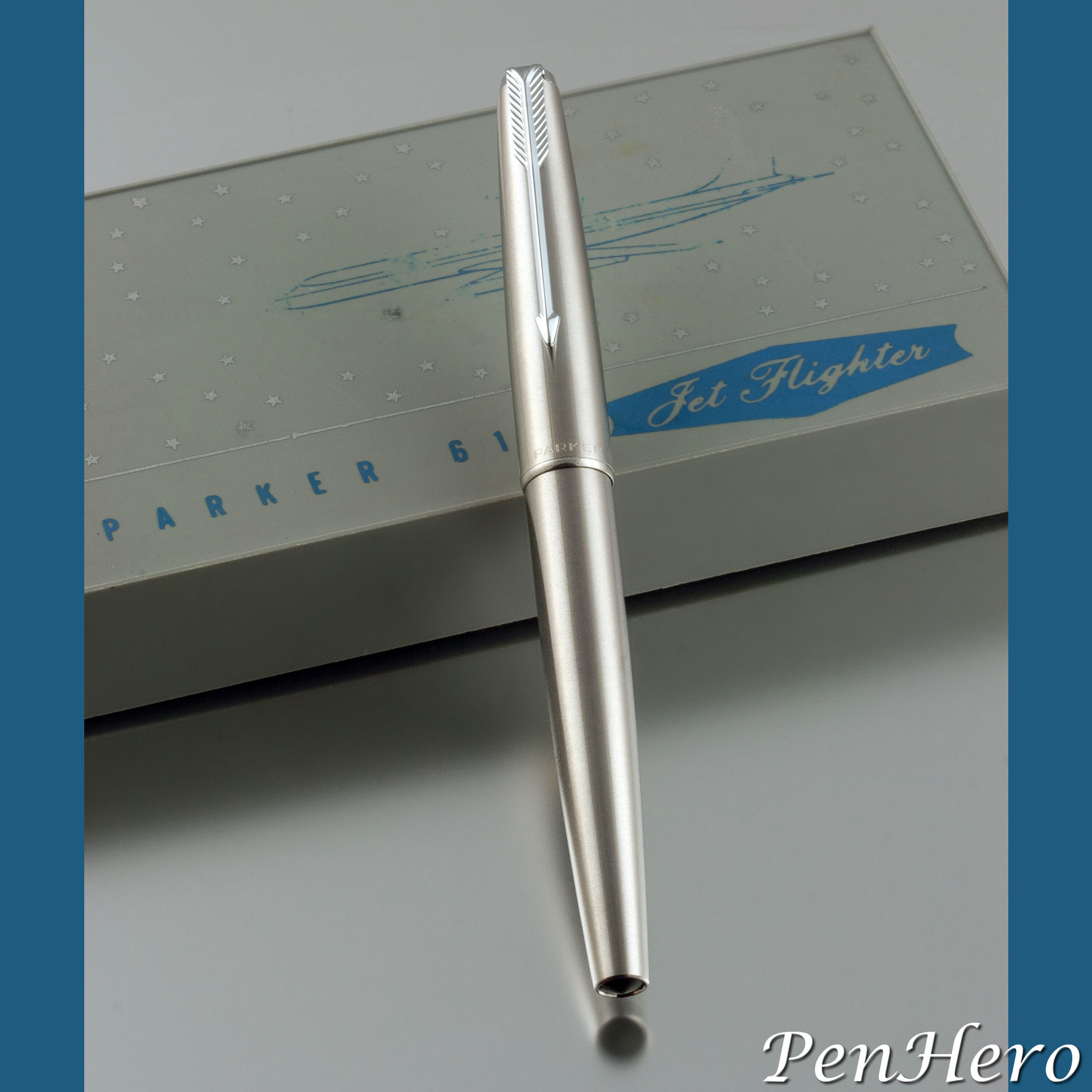 Parker 61 Jet Flighter 1959-1962
Parker 61 Jet Flighter 1959-1962
The 1950s was the dawn of the jet age for commercial airline passengers. The de Havilland Comet, designed in the 1940s and first test flown in 1949, was the first jetliner to enter commercial airliner service on May 2, 1952 with British Overseas Airways Corporation (BOAC). Boeing’s 707 first flew with National Airlines in 1958. The first Douglas DC-8 was delivered to Delta Airlines on July 22, 1959 and its first flight for the company was a “2,497 mile route from the Douglas plant in Long Beach, California, to Miami” taking just 4 hours and 43 minutes. The Douglas DC-8 entered regular service with Delta Airlines September 18, 1959, with its first commercial flight from New York to Atlanta. Delta retired its last DC-8 May 1, 1989. Testing the new pen on the Douglas DC-8 features in many early Parker 61 Jet Flighter advertisements.
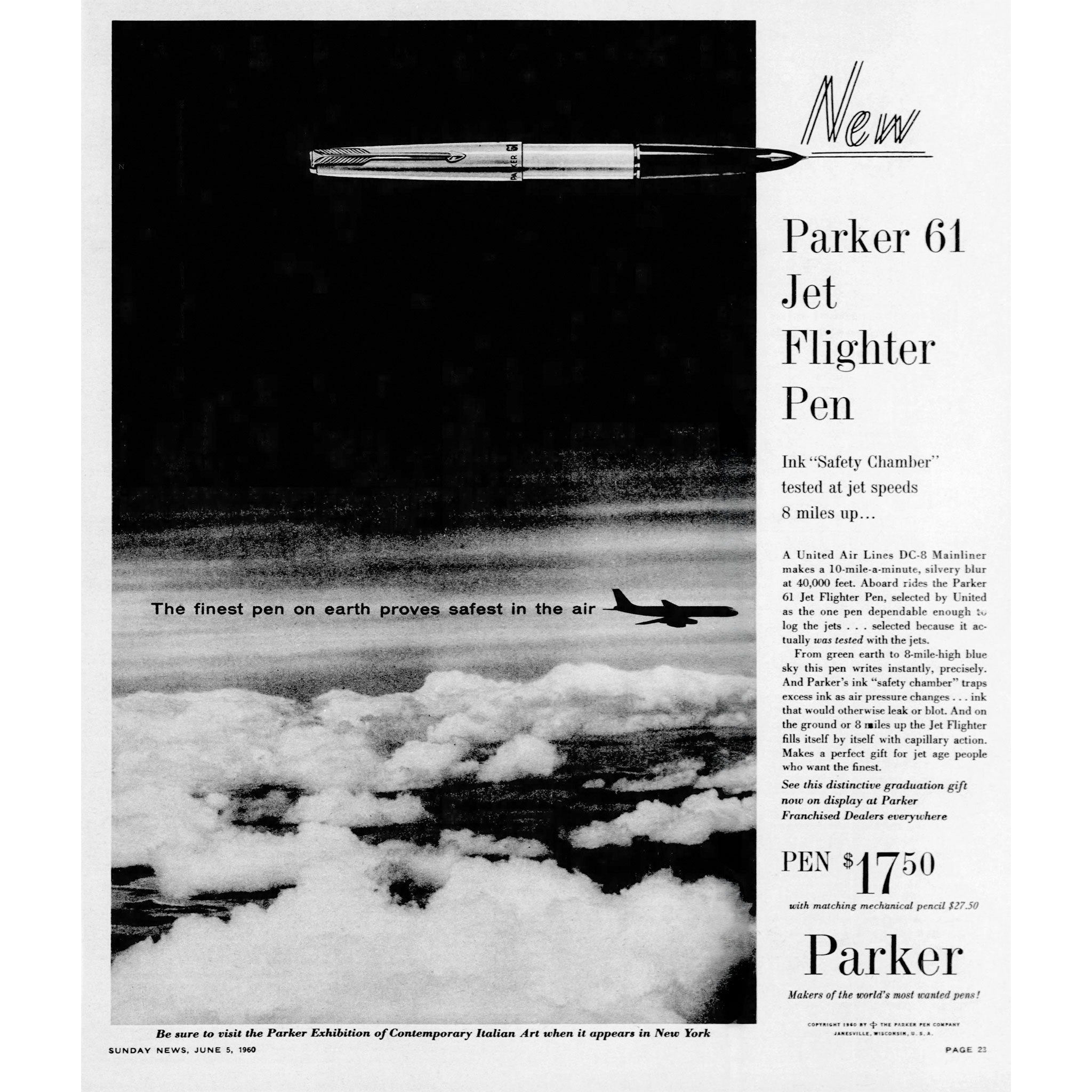 Advertisement in the June 5, 1960 New York Daily News
Advertisement in the June 5, 1960 New York Daily News
Inspired by the jet age, Parker introduced the 61 Jet Flighter model in September 1959 with its cap and barrel made of "Lustraloy" brushed stainless steel, chrome plated trim, and fitted with a 14 karat gold hooded nib unit. It was packaged in a special box with graphics of the Jet Flighter name with a Douglas DC-8 silhouette. The 61 Jet Flighter is more angular, more tapered, and narrower than its 51 Flighter predecessor. Both the cap top and barrel end of the 61 Jet Flighter are fitted with gray plastic "jewels." According to Tony Fischier’s “Parker ‘61’” article, the 61 Jet Flighter was replaced by a gold trim Flighter as of 1962. Retailer advertisements for the chrome trim 61 Jet Flighter taper off sharply after 1962, bearing this out.
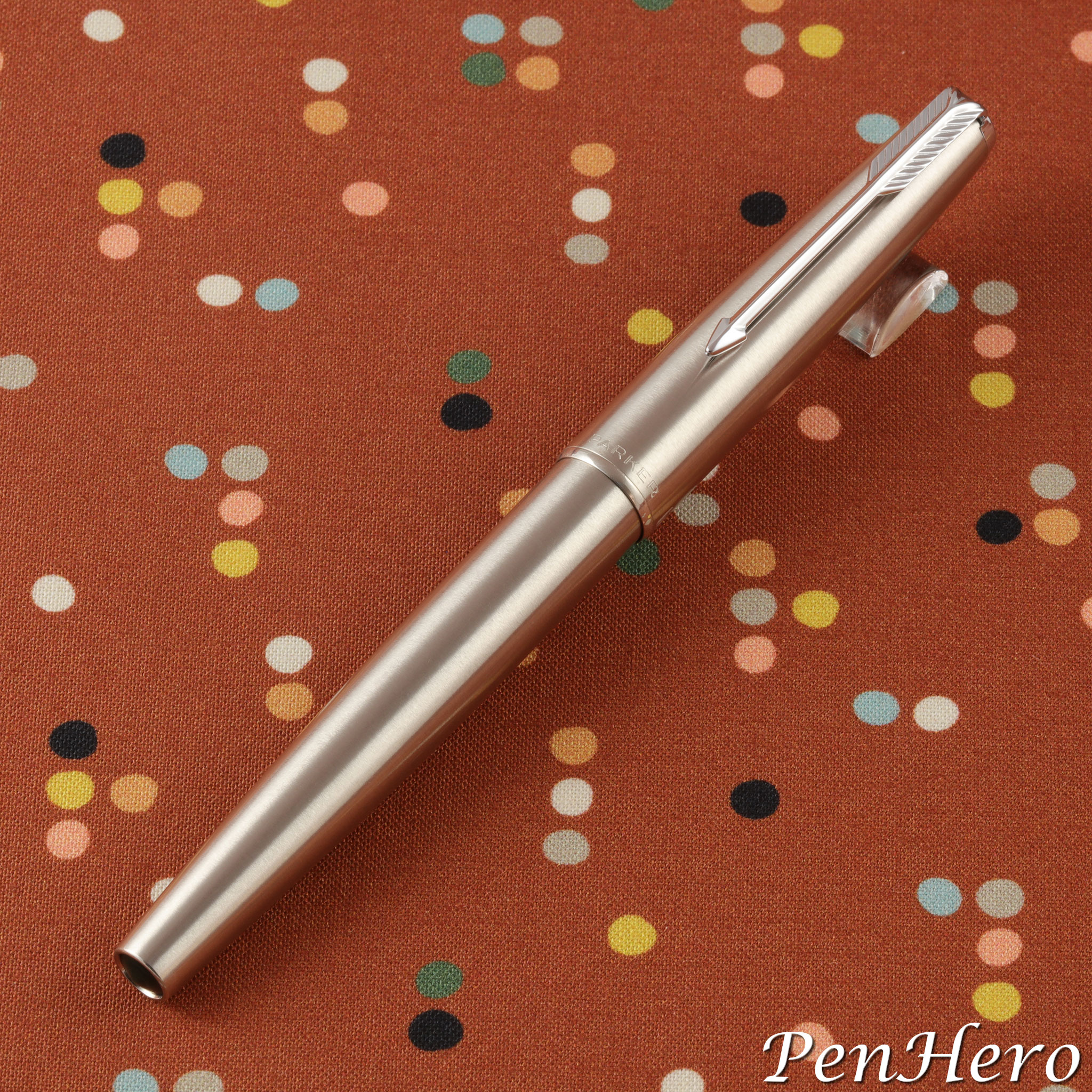 Parker 61 Jet Flighter 1959-1962
Parker 61 Jet Flighter 1959-1962
Why the Douglas DC-8 connection? The DC-8 was part of the new wave of American made jetliners and the association would tie the pen to high tech. Parker formally announced the new pen to retailers in the September 1959 Parkergrams U.S.A. It describes that the 61 Jet Flighter “met and surpassed every performance standard at 40,000 feet.” United Air Lines vice president of flight operations I. E. Sommermeyer is quoted saying, "After examining actual test results, I can say this exciting new Parker pen measures up in full to the exacting standards of quality and performance that United demands of the equipment we operate." Finally, the announcement ties the look of the pen to the plane and says how the packaging, banners, and point of sale displays feature the Douglas DC-8 silhouette.
The earliest ad I found for the Parker 61 Jet Flighter is interestingly in the August 24, 1959 Long Beach, California Independent. I’m guessing that retailer had to know about the testing and was given the new pens early. It says the following:
Tested in Long Beach’s own DC-8s!Proved trouble-free at 40,000 feet in actual tests made in the new DC-8’s. Designed, tested, proved and approved for jet flight conditions. No leakage … ink flowed smoothly from its special vacuum controlled reservoir. Distinctive and new in its design as the mighty DC-8.
The ad continues to describe the pen as only available in “satin-finish Lustraloy,” Parker’s name for its brushed stainless steel, used for both the cap and barrel. The price is $17.50 for the fountain pen and $27.50 for the pen and a matching pencil, presented in a special “Parker 61 Jet Flighter” case with a line drawing of a Douglas DC-8 plane.
The new Parker 61 Jet Flighter was heavily advertised, particularly in retailer ads. I found nearly 300 advertisements listed in newspapers in 1959 and 1960 alone. Parker also supported their retailers in their national advertising. A two-page advertisement in the April 4, 1960 issue of Life magazine I’ve seen includes a full page listing of dealers in fourteen states. I imagine Life must have had multiple regional editions with different lists of dealers. Parker tried to protect even taglines in Parker 61 advertisements registering several copyright phrases including one for the Jet Flighter: “The finest pen on earth proves the safest in the air” in the June 5, 1960 Philadelphia Inquirer.
Identification Guide and Features:
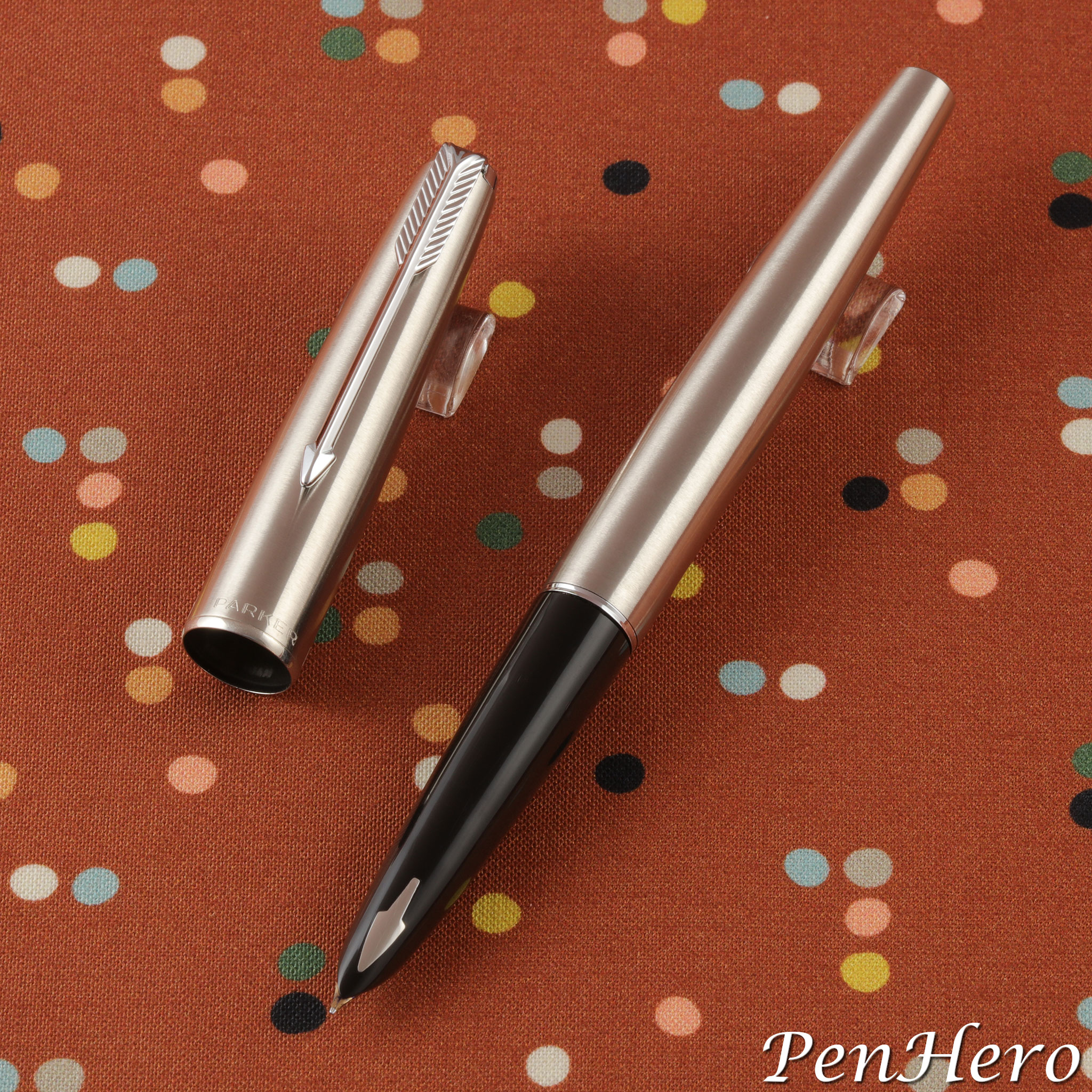 Parker 61 Jet Flighter 1959-1962
Parker 61 Jet Flighter 1959-1962
The Parker 61 Jet Flighter has a "Lustraloy" brushed stainless steel cap and barrel, chrome plated trim, and is fitted with a 14 karat gold hooded nib unit. The box had special graphics of the Jet Flighter name with a Douglas DC-8 silhouette. The 5 1/8 inch long 61 Jet Flighter has a tapered cap and barrel, each fitted with gray plastic "jewels."
- "Lustraloy" brushed stainless steel cap and barrel
- Chrome plated arrow clip
- Black plastic nib section with inlaid chrome plated arrow
- PARKER stamped on the front cap lip below the clip, 61 on each side, and MADE IN U.S.A. under the Parker "halo" logo on the back
- Slip on cap
- 14 karat gold hooded nib
- Nib grades included accountant, extra fine, fine, medium, broad, stub, and medium oblique
- Capillary filler
- 5 1/8 inches long capped
- Retail price was $17.50 for the fountain pen, $27.50 with matching mechanical pencil
Performance
This Parker 61 Jet Flighter is a standard length, very tapered, lightweight pen at 0.7 ounce and about 5 1/4 inches long capped and 5 5/8 inches with the cap posted on the end of the barrel. Parker 61s post deeply and securely and I like the feel in the hand with the cap posted better than without. It's just a little too short without the cap on the end of the barrel.
The capillary filling system makes the Parker 61 a very convenient pen to use. As shown in the 1950s advertisements, unscrew the barrel, drop the nib section into the ink bottle back end first and wait. Usually after 30 seconds the pen is filled and ready to write. If the outside of the filling unit is not scratched up or scarred, it won't even need to be wiped when inserted back into the barrel, as the Teflon coating really does drop the ink right back into the inkwell. Take care, as the base of the filling unit can let a drop or two go if the nib section is not handled carefully.
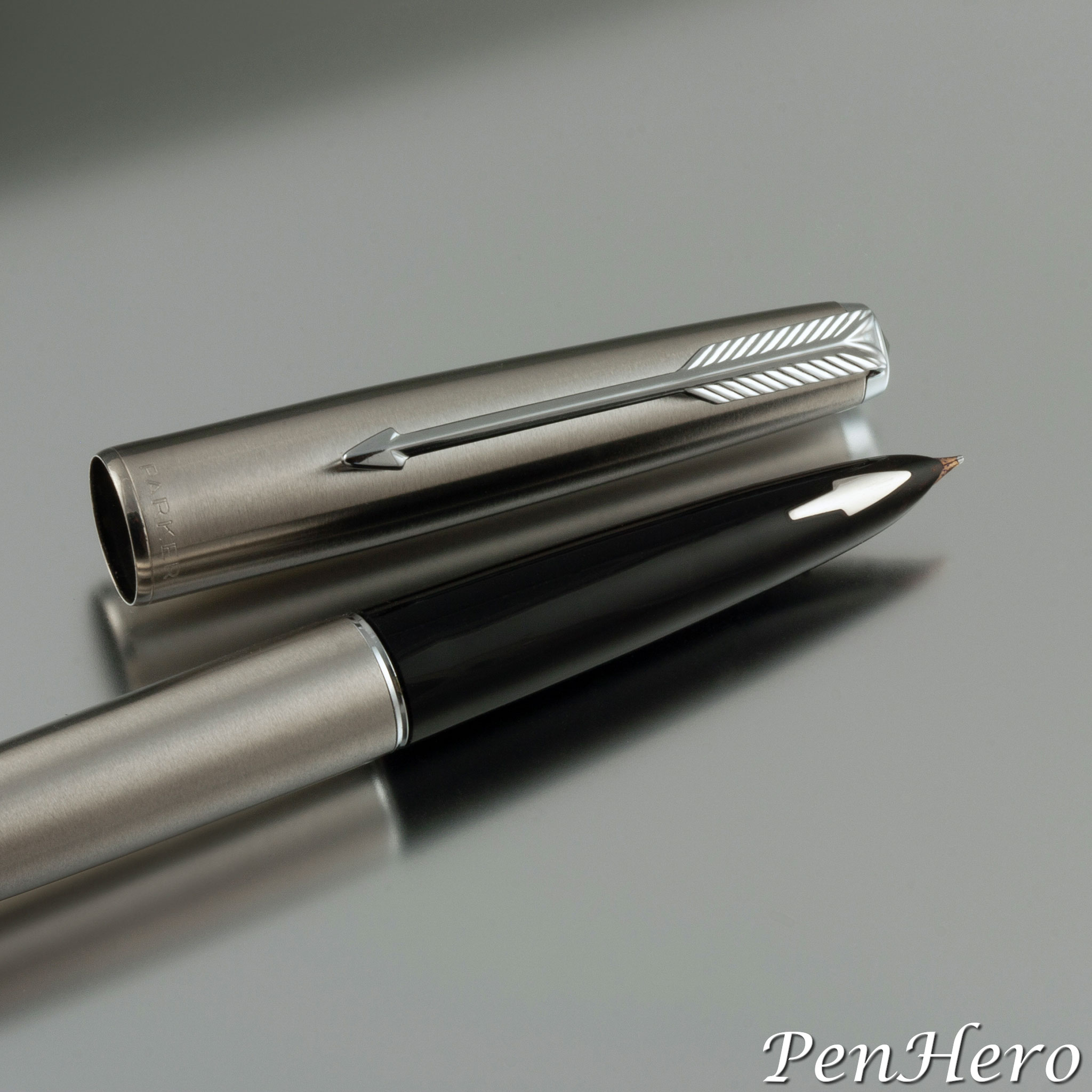 Parker 61 Jet Flighter 1959-1962
Parker 61 Jet Flighter 1959-1962
One tricky thing about Parker 61s is finding one used but never flushed. It may not fill correctly, due to dried ink clogging up the capillary unit. This is fairly easy to fix, but requires a bulb unit, like on a baster, though with a much smaller opening. These can sometimes be found in kits at pharmacies. The cleaning method is to put bulb over the base of the filling unit and squeeze water into and out of the nib section until it flushes clear. If the pen is not badly clogged it may also be primed by dipping the nib into the ink for a few seconds allowing the front end of the feed to wet.
As with a Parker 51, writing with the Parker 61 is not about gazing at a fancy nib, it's about a reliable pen that writes well. The brushed stainless steel finish on the 61 is duller than on the 51 and the pen is much more slender. It's a good fit in the hand if you like a smaller pen. The nibs on all the 61s I have tried are a little drier writing than the 51, which means writing takes a little more effort.
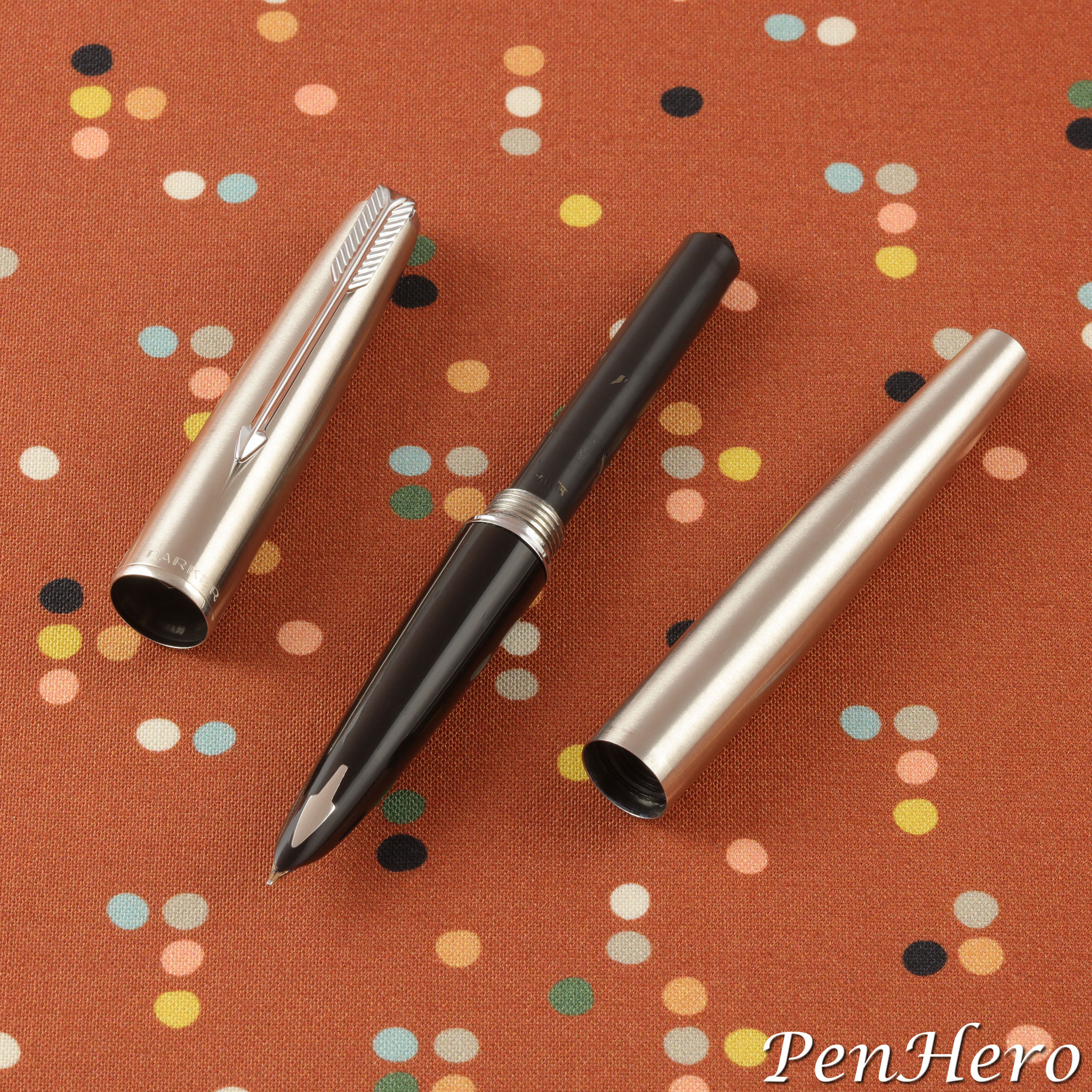 Parker 61 Jet Flighter 1959-1962
Parker 61 Jet Flighter 1959-1962
There are three common problems with capillary filling Parker 61 pens. The most obvious is a pen that was left with dried out ink in it. As described above, this can be cleared with some work using a bulb unit to flush out the pen. The second is the tendency for the little Arrow inlay in the front of the nib section to fall out. It can be replaced, but may require a donor pen. Third, as seen in the photo above, is scuffed up capillary cells. While primarily a cosmetic problem, the filling unit won't shed ink as easily and will require a wipe before replacing the barrel.
The Parker 61 had a long run, from 1956 through 1983, and many different models were made, from Lustraloy cap and plastic barrel models to high end solid gold pens. A collector focusing on the 61 will have to work hard to capture all the variations and it will be a serious hit on the wallet. Parker 61s made after 1969 are cartridge / converter pens, adding another dimension to the line. My preference is the capillary type, both from a user and a collector point of view. These are really high quality pens that are too often overlooked.
References
“5/30/1958: First Flight of the Douglas DC-8” by Helwing Villamizar, Airways, May 30, 2023, Copyright © 2024 Airways Publishing
“12/10/1958: First Jet-Powered US Domestic Flight” by Lee Cross, Airways, December 12, 2023, Copyright © 2024 Airways Publishing
Advertisement, Life, August 26, 1957, page 12
Advertisement, Life, December 2, 1957, page 86
Advertisement, Life, November 11, 1957, page 84
Advertisement, Life, October 14, 1957, page 178
Advertisement, Life, September 16, 1957, page 48
Advertisement, Life, April 4, 1960, pages 82-83
Advertisement, The Daily News, New York City, June 5, 1960, page A-3
Advertisement, The Daily News, New York City, June 5, 1960, page 23
Advertisement, The Independent, Long Beach, California, August 24, 1959, page 31
Advertisement, The Philadelphia Inquirer, June 5, 1960, page 31
“Comet – The First Jet Airliner” © 2020 Royal Air Force Museum
“Current Registrations 1960” Catalog of Copyright Entries, Library of Congress Copyright Office, page-137
“Douglas DC-8 1959-1989” Delta Flight Museum
"Identification With Impact!" Parkergrams, March 1958, © copyright The Parker Pen Company, Janesville, Wisconsin
“Parker ‘61’” © 1995-2019 Tony Fischier and The Parker Pen Company®/Sanford Ecriture
Parkergrams U.S.A., September 1959, page 1, © copyright The Parker Pen Company, Janesville, Wisconsin
"Strictly Commercial: Demonstration Creates Sales" Parkergrams, by Art Foster, April 1957, © copyright The Parker Pen Company, Janesville, Wisconsin
"Two-Product Advertising Tops $1 Million Mark" Parkergrams, September 1957, © copyright The Parker Pen Company, Janesville, Wisconsin
Interact
Comments on this article may be sent to the author, Jim Mamoulides


